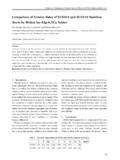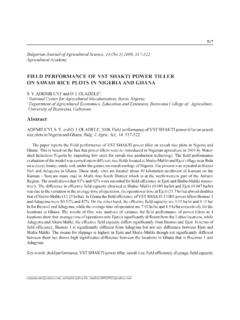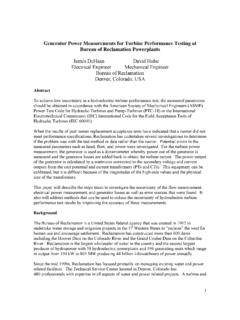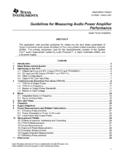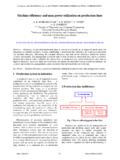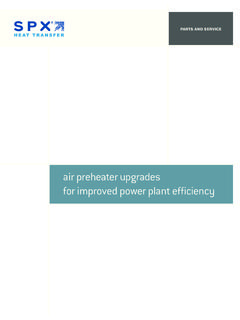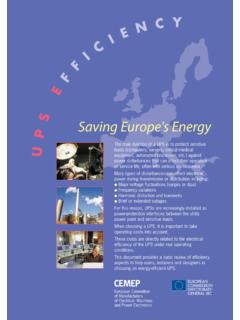Transcription of A 36 W Wireless Power Transfer System with 82% …
1 32 Transactions of The japan institute of Electronics packaging Vol. 6, No. 1, 20131. IntroductionRecently, interest in Wireless Power Transfer (WPT) technology has been growing substantially. This technol-ogy can be applied to charge or Power electronic devices wirelessly. WPT further contributes to technical fields such as medical science and automobile industr y. A WPT System consists of a transmitter, coupling coils, a receiver, and matching circuits. The matching circuits between each System block are introduced to transform the imped-ance in order to confirm the System blocks operate at cor-rect input and output impedance condition. However, the matching design depends on the load resistance in the receiver.
2 When the resistance changes, the efficiency of the receiver drops due to the mismatch, resulting in a drop in coupling coefficient which consequently causes a drop in efficiencies of the transmitter and overall System . In this study, the turn-on resistance of the LED module is 30 , thus, the System design is based on this design challenge is the transmitter circuit. It determines the performance of WPT systems. Generally, Class-D Power amplifiers are chosen to realize the trans-mitter, but it requires at least two transistors to achieve zero voltage switching (ZVS), increasing the cost of prod-ucts and introducing process yield problems. This study selects Class-E Power amplifier circuit structure which is also a switching type amplifier.
3 It has fewer components with high reliability and a low-cost advantage, with a theo-retical efficiency of 100%.[1] However, compared to Class-D Power amplifiers, Class-E Power amplifiers are more sensitive to the output impedance. Understanding the methodology on how to design an accurate output imped-ance of the Class-E Power amplifier is the crucial aspect in the System implementation. In this study, the matching circuit between the Class-E Power amplifier and transmit-ting coil is combined with the capacitor of the resonating circuit in the Class-E Power amplifier, simplifying the sys-tem structure while keeping the same main methodologies are introduced to achieve Wireless Power transmission, including electromagnetic coupling, magnetic resonance, and microwave Power transmission.
4 [2, 3] Among these technologies, electro-magnetic coupling is the most suitable solution for LED lighting applications. It can achieve efficiency levels of at least 70% for distances of several millimeters to several centimeters between the transmitting and receiving coil. For designing the coils, the quality factor Q is the key parameter. In order to obtain the high quality factor, this study uses Litz wire to fabricate the coils to improve the this paper, section 2 describes the design and mea-[Technical Paper]A 36 W Wireless Power Transfer System with 82% Efficiency for LED Lighting ApplicationsWei-Ting Chen*, Raul A. Chinga**, Shuhei Yoshida**, Jenshan Lin**, and Chao-Kai Hsu**Electronics and Optoelectronics Research Laboratories, Industrial Technology Research institute , Hsinchu 31040, Taiwan, ROC**Department of Electrical and Computer Engineering, University of Florida, Gainesville, Florida 32611, USA**Green Innovation Research Laboratories, NEC Corporation, Tsukuba, Ibaraki 305-841, japan (Received July 26, 2013; accepted October 25, 2013)AbstractThis paper presents the design and implementation of an LED lighting module powered by a Wireless Power Transfer System .
5 The overall System achieves an efficiency of 82% with an output Power of 36 W when the load resistance in the receiver is 30 , which is the turn-on resistance of the LED lighting module. The transmitter of the System adopts Class-E Power amplifier structure instead of Class-D, to decrease the number of transistors and its cost. The coils of the System are designed by electromagnetic coupling methodology and realized by Litz wire to reach high efficiency. Matching cir-cuits between the System blocks are also discussed in this paper in order to obtain the excellent System : Wireless Power Transfer , Class-E Power amplifier, Electromagnetic coupling, Litz wire, LEDC opyright The japan institute of Electronics Packaging33 Chen et al.
6 : A 36 W Wireless Power Transfer System with 82% Efficiency (2/6)surement results of a 38 W Class-E Power amplifier with 93% efficiency. The content also includes the experiment of var ying the amplitude of driving clock signal to examine the performance of the Class-E. The implementation of the WPT System is demonstrated in section 3. The discussion of load resistance variation is also presented. Section 4 shows the LED lighting module powered by the designed WPT circuit. Finally, the conclusion of this work is pre-sented in section High Performance Class-E Power AmplifierFigure 1 shows the schematic diagram of the Class-E Power amplifier which is used to convert DC Power to AC Power .
7 The output Power capability of a WPT System is related to the maximum output Power of the DC-AC inverter. In order to obtain a higher output Power , the value of load resistor R of the Class-E Power amplifier should be smaller. That is because the Class-E Power amplifier will be driven by a higher current, and the output Power will dramatically increase when the biasing voltage is at the same condition. However, according to the equa-tions listed in [3], the Class-E Power amplifier needs a smaller C1 to operate normally when a smaller R is cho-sen. Therefore, a transistor with small parasitic capaci-tance Cds is a better choice to design a high output Power Class-E Power amplifier.
8 [4] In this study, the transistor IRF640 with less than 200 pF parasitic capacitor Cds was selected when the drain to source voltage is over 30 V. Considering the value of load resistor R should be higher than parasitic resistance of L2 to reduce the Power loss in the inductor, a 10 load resistor was used to be the initial condition for the equations listed in [3]. Selecting 240 kHz as the operating frequency, the other component values are L1 = 500 H, C1 = nF, C2 = 54 nF, L2 = 18 H. Con-sidering the maximum output Power is over 38 W, these components have the characteristic of high voltage and current rating. The quality factor of the components was also considered to reduce the Power loss in the compo-nents.
9 The 240 kHz clock operating the transistor M1 is generated by Agilent 33521A waveform generator. Figure 2 shows the implemented Class-E Power amplifier. Figure 3 6 show the performance of the circuit, and the wave-forms and output Power are measured by using a current probe (Tektronix P6021), voltage probes (Tektronix P2220) and an oscilloscope (Tektronix TDS2004B).Figure 3 displays the drain voltage waveform and the clock signal of 50% duty cycle at the gate of the transistor M1 when VDD of 25 V was applied. As shown, the drain voltage drops to zero right before the transistor is turned on, preventing the overlap between these two waveforms. This proves that the Class-E Power amplifier achieves proper zero voltage switching condition.
10 Figure 4 shows the output voltage and current waveforms. Since they are both in phase, the Class-E can yield the maximum possible output Power . Figure 5 is the output Power and drain effi-ciency versus drain supply voltage. When the supply volt-age VDD is 32 V, the output Power is W with a drain efficiency of 93%. The correlation among the amplitude of the clock signal, the output Power and the drain efficiency is summarized in Fig. 6. The amplitude of the clock signal is varied from 5 V to 10 V while the supply voltage VDD remains at 25 V. The result shows how the circuit per-Fig. 1 Schematic diagram of the Class-E Power 2 Photograph of the Class-E Power 3 Drain and gate of The japan institute of Electronics packaging Vol.



